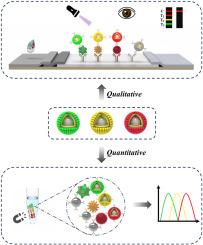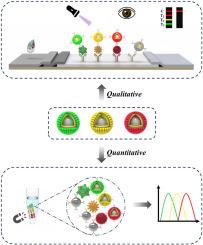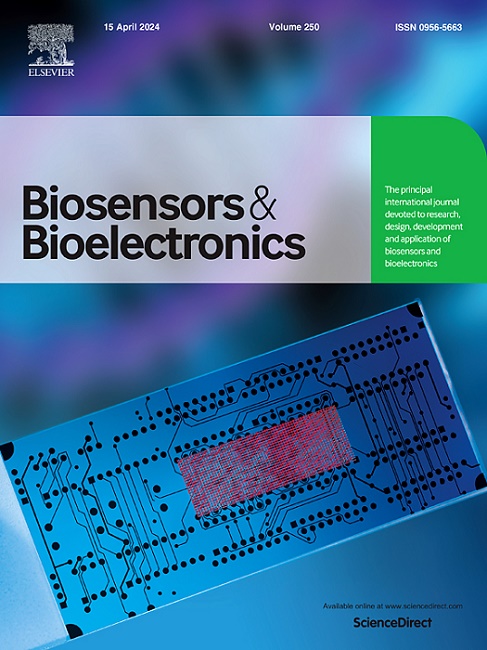Development of immunochromatographic and homogeneous assay based on quantum dot-functionalized polystyrene nanoprobes for the qualitative and quantitative screening of respiratory viruses
IF 10.7
1区 生物学
Q1 BIOPHYSICS
引用次数: 0
Abstract
Accurately differentiating respiratory diseases caused by viruses is challenging because of the similarity in their early or clinical symptoms. Moreover, different infection sources require different treatments. However, the current diagnostic methods have limited differentiating efficiency and sensitivity. We developed a dual-system immunosensor with a bilayer fluorescent label as a signal amplifier for the on-site, sensitive, and accurate identification of multiple respiratory viruses (RVs). The nanomaterial, comprising a polystyrene (PS) nanosphere core encapsulated by two layers of CdSe@ZnS-COOH quantum dots (QDs), outperforms the conventional color and fluorescent labels in RV detection. The dual-system detection platform, comprising a PS@DQD-based lateral flow immunoassay (LFIA) and a PS@DQD-based homogeneous sensor, enables qualitative and quantitative screening of multiple respiratory viruses within 10 and 30 min, respectively, depending on the specific detection requirements for different application scenarios. This remarkable method provides 51.2 to 1000 times sensitivity improvement over commercial antigen detection kits and greater than 12.5 to 100 times improvement over QD-based immunosensors. Furthermore, we comprehensively evaluated the specificity, reproducibility, and stability of the integrated dual-system detection platform, demonstrating its reliability. Remarkably, the respiratory viral testing was validated using biological samples, thus illustrating its promise and convenience in the detection of respiratory viruses.


基于量子点功能化聚苯乙烯纳米探针的免疫层析和均相测定的开发,用于呼吸道病毒的定性和定量筛查
由于病毒引起的呼吸道疾病的早期或临床症状相似,因此准确区分这些疾病具有挑战性。此外,不同的感染源需要不同的治疗方法。然而,目前的诊断方法在区分效率和灵敏度方面都很有限。我们开发了一种双系统免疫传感器,以双层荧光标签作为信号放大器,用于现场、灵敏、准确地识别多种呼吸道病毒(RV)。这种纳米材料包括一个由两层 CdSe@ZnS-COOH 量子点(QDs)封装的聚苯乙烯(PS)纳米球核,在 RV 检测方面优于传统的彩色和荧光标签。该双系统检测平台由基于 PS@DQD 的横向流动免疫分析法(LFIA)和基于 PS@DQD 的均相传感器组成,可根据不同应用场景的具体检测要求,分别在 10 分钟和 30 分钟内对多种呼吸道病毒进行定性和定量筛选。与商业抗原检测试剂盒相比,该方法的灵敏度提高了 51.2 到 1000 倍;与基于 QD 的免疫传感器相比,灵敏度提高了 12.5 到 100 倍。此外,我们还全面评估了集成双系统检测平台的特异性、可重复性和稳定性,证明了其可靠性。值得注意的是,呼吸道病毒检测使用生物样本进行了验证,从而说明了其在呼吸道病毒检测方面的前景和便利性。
本文章由计算机程序翻译,如有差异,请以英文原文为准。
求助全文
约1分钟内获得全文
求助全文
来源期刊

Biosensors and Bioelectronics
工程技术-电化学
CiteScore
20.80
自引率
7.10%
发文量
1006
审稿时长
29 days
期刊介绍:
Biosensors & Bioelectronics, along with its open access companion journal Biosensors & Bioelectronics: X, is the leading international publication in the field of biosensors and bioelectronics. It covers research, design, development, and application of biosensors, which are analytical devices incorporating biological materials with physicochemical transducers. These devices, including sensors, DNA chips, electronic noses, and lab-on-a-chip, produce digital signals proportional to specific analytes. Examples include immunosensors and enzyme-based biosensors, applied in various fields such as medicine, environmental monitoring, and food industry. The journal also focuses on molecular and supramolecular structures for enhancing device performance.
 求助内容:
求助内容: 应助结果提醒方式:
应助结果提醒方式:


